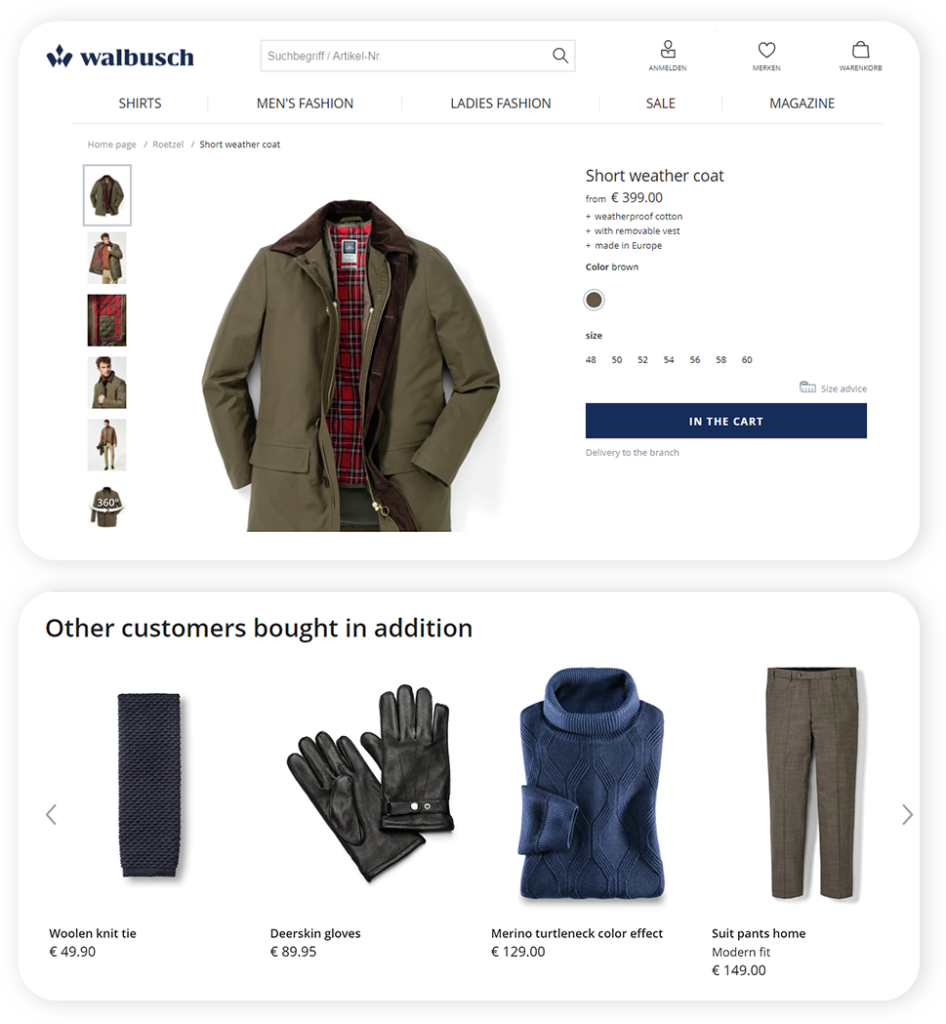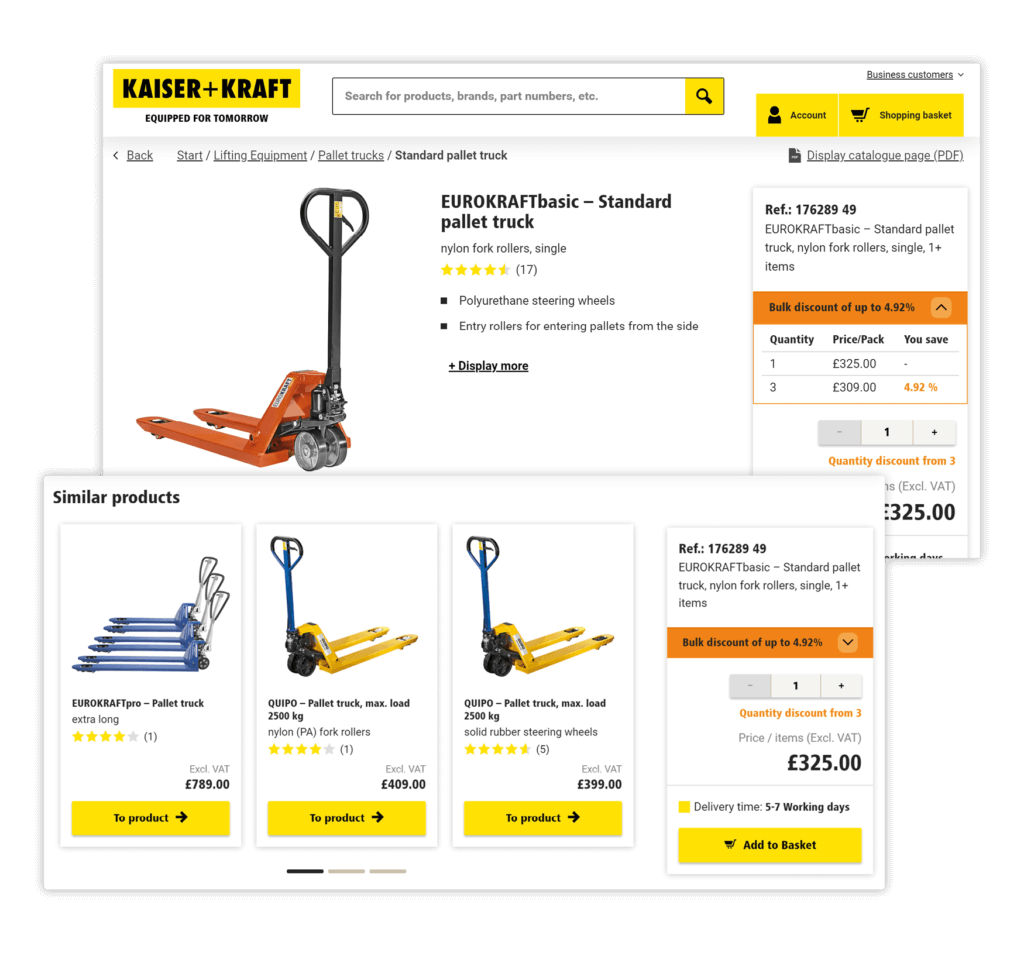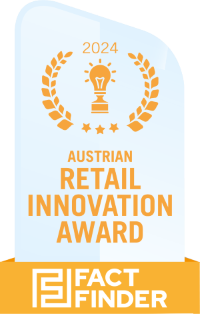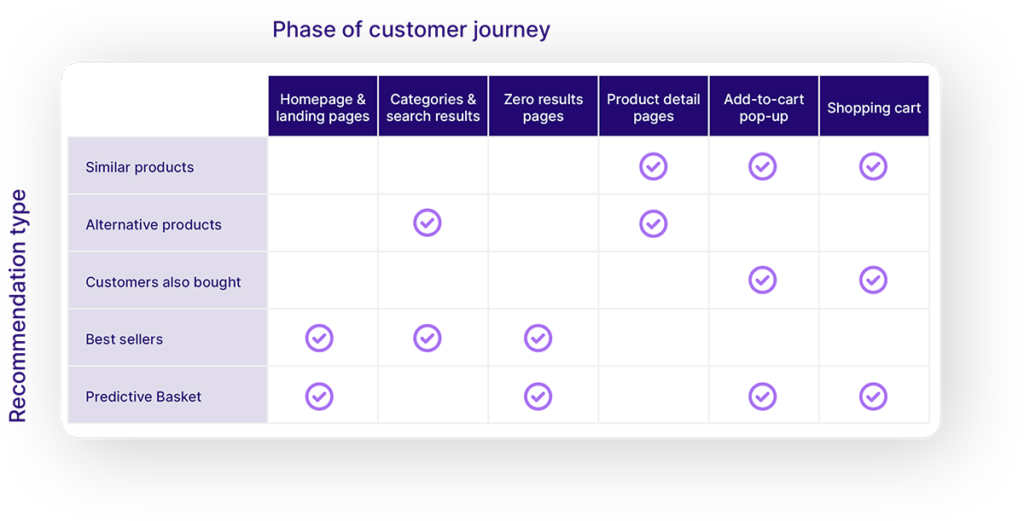AI product recommendations can increase revenue by 10%. Others rarely convert, just wasting time and effort. So, how can you get more ROI from your online shop’s recommender system with less of the work?
What makes a product recommendation clickable?
Shoppers who engage with AI product recommendations have a 26% higher average order value (AOV). They’re 4.5% more likely to complete their purchase and they spend 5x more than other shoppers per visit. But how do you get those people to engage with your recommendations in the first place? One word: relevance.
Product recommendations that pick up on each customer’s unique preferences and search intent speed up shopping journeys, boost basket sizes and deliver tailored experiences that turn first-time visitors into life-long fans of your brand.
The best part is, setting up highly relevant recommendations like this doesn’t need to take much time. Thanks to AI, you can deliver inspiring one-to-one buying journeys without any manual segmentation, third party data or long learning curve.
In this blog post, we’ll break down the types of product recommendations you need to know about, best practices for how to drive efficiencies with AI and the incredible impact they can have on your business — including real-life use cases.
First things first: product recommendations aren’t just about increasing conversions
A strong recommendation strategy starts with a clear goal. So, what are you really trying to achieve? Is it more items per basket? Higher conversion rates? A bigger AOV?
Sometimes, these mean the same thing, but not always. Cheaper products often convert better, so even if customers buy lots of products, your AOV could end up lower than if they just stuck with one high-value item. Hence, it’s best to balance tailored cross-sells with strategic upsells, which don’t just increase conversions but also make a meaningful difference to your bottom line.
How most product recommender systems work
Basic product recommendations fall into four main styles:
Cross-selling with user-based recommendations
Often featured on product detail pages and in the cart under headings like “other customers also buy”, user-based recommendations draw on customer behavior and combined sales to suggest popular add-ons for specific products — like knowing cotton wool pads go well with nail polish remover.
You can set up basic recommendations like this without AI, which generally works well for around 10% of your products.
Best practice: Walbusch
 “Other customers also buy” recommendations in a fashion shop: In this example, our customer Walbusch cross-sells additional products in the online shop
“Other customers also buy” recommendations in a fashion shop: In this example, our customer Walbusch cross-sells additional products in the online shop
But what about the other 90%?
They won’t have such a strong connection. For one thing, buying behavior varies from session to session and user to user. But also, your product range constantly changes as trends emerge and fade, spring/summer turns to autumn/winter and new releases replace older ranges, clearing out existing connections between products.
So, how do basic AI recommender systems keep their suggestions relevant for the remaining items?
Upselling using product-based recommendations
Ideal for upselling on product pages, product-based recommendations don’t require your shop to learn anything first. They just consider similar items to the one being viewed. Most basic recommendation engines understand which products are similar via:
- Image recognition – Image recognition is great at spotting general visual similarities, but it struggles with finer distinctions, so it might think a coat rack and a kitchen roll holder belong in the same category.
- Natural language processing – Other recommender systems use product descriptions to understand how items relate to each other. Yet, since most descriptions aren’t that detailed, the engines rely on limited attributes, like color, so they might suggest a pink babygrow for someone viewing a pink handbag.
Best practice: Kaiser+Kraft
 Similar products as recommendations in B2B shops: In this example, Kaiser and Kraft recommend higher-priced pallet trucks.
Similar products as recommendations in B2B shops: In this example, Kaiser and Kraft recommend higher-priced pallet trucks.
- Best sellers and novelty items as a multi-use tool – You can recommend best-selling products and novelty items almost everywhere on your site, but they work best on generic pages, like the homepage, where personalization hasn’t yet taken effect for new visitors. Your recommendation engine only needs to know which products you’ve sold the most and which are limited edition.
How advanced AI helps you get product recommendations right every time
Thanks to advances in AI, we’re no longer limited to NLP, image recognition or manual merchandising. Sophisticated recommender systems now understand context, using minimal data to deliver real-time relevance.
In a nutshell, the engine maps product attributes to neurons, which learn from customers’ interactions on your website to understand which products go together, and which don’t. Even from individual combined purchases, your system can spot patterns between categories. And any updates you make to your database instantly appear on the front end, so new and niche products are just as likely to be recommended as your staples are. This is a game changer for online shops with frequent launches. Plus, it enhances personalization, showing individuals the items they really want, even if they’re less popular.
Talking about personalized recommendations, AI’s a big help there, too. Forget micro-segmentation, which requires masses of data, often misses the mark and generates few conversions. Now, your shop can use individuals’ browsing and buying behavior to tailor recommendations to their personal preferences, from favorite brands, colors and sizes to dietary requirements and price ranges. And because it understands context, it also matches their current search intent, recommending what they need in the moment, rather than more of what they’ve looked at before.
We’re not talking about the generic cross-sells you see on too many online shops that barely relate to the customer and what they’re looking at (like recommending trending cheese pizzas to a vegan.) We’re talking about the personalized picks that engage shoppers, keep them adding to the cart and turn them into the high-value customers that grow your AOV.
Next-level predictive recommendations
So, we’ve talked about product recommendations that encourage new purchases. But how about helping customers reorder? Fast, easy reordering is key for online shops selling products people buy regularly, like groceries, prescriptions, self-care items or business supplies.
That’s where the Predictive Basket comes in, making proactive suggestions to simplify reordering. By learning from individual buying habits and broader shopper behavior, the AI predicts when a customer needs to restock everyday items like milk and when they’ll want their occasional favorites, like jelly.
It also tracks seasonal trends. For example, if a customer buys charcoal every two weeks in summer, the Predictive Basket will show charcoal products at just the right time. When the weather changes and few customers buy them, it adjusts and replaces barbecue-related product recommendations with items they buy more in autumn.

Award-winning technology
The Predictive Basket received the Austrian Retail Innovation Award for Best Online Innovation, marking a significant milestone in eCommerce innovation. This recognition highlights its unique ability to simplify reordering and transform the online shopping experience.
Learn more.
Where can product recommendations be used?
See which recommendation types work best at each step of the customer journey with this handy chart.

Checklist for your recommendation engine
Let’s wrap up with a quick checklist of what to consider when selecting and using your recommendation engine. A decent system should:
- Use multiple data sources — including both combined sales and individual user affinities. It generally pays to show a variety of recommendations on product detail pages.
- Draw smart conclusions from individual combination sales — so you don’t have to collect data for months to deliver relevant recommendations. This way, you’ll see a much faster and higher ROI.
- Learn from customer behavior in a GDPR-friendly way — by using session ID rather than third-party cookies, so your recommendations will always be on-point.
Need help shaping your recommendation strategy? With over 20 years of experience helping eCommerce businesses fine-tune their search and recommendation setups, we’d be happy to show you what’s possible. Get in touch for a demo and see how you can unlock your online shop’s full potential.
